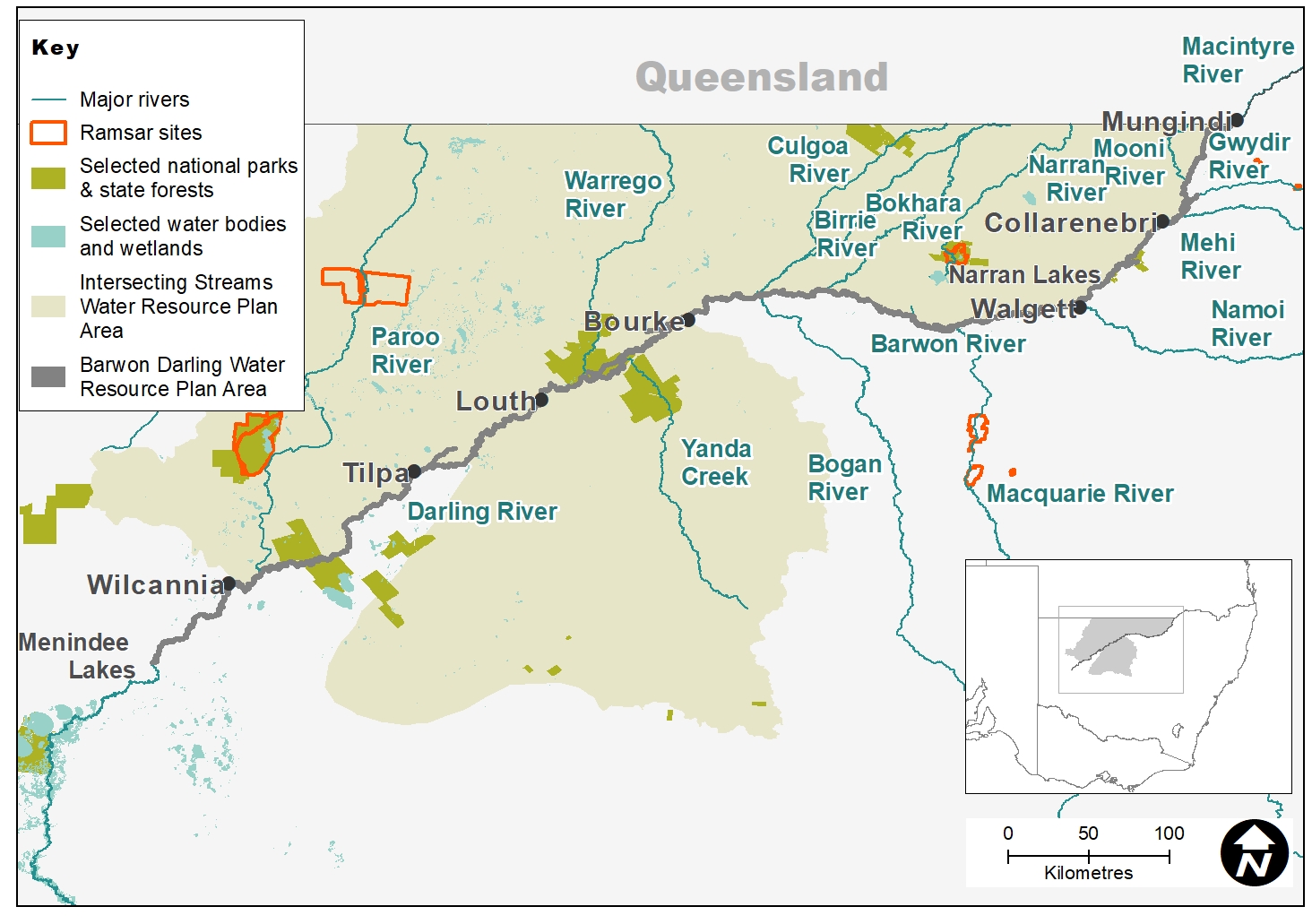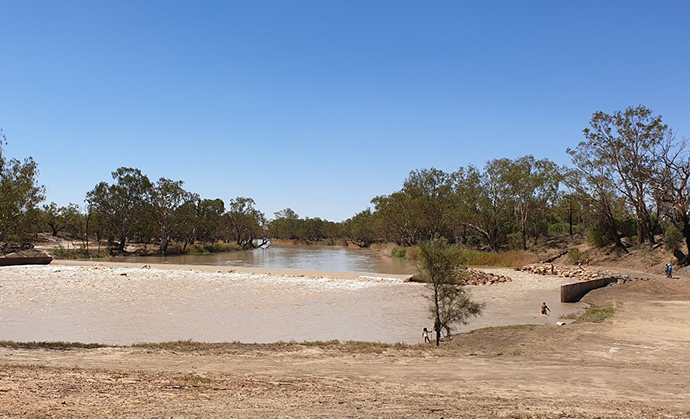The Barwon–Darling watercourse connects the river systems of the northern Murray–Darling Basin with those of the south. Several major river systems flow into the Barwon–Darling including the Culgoa, Gwydir, Macintyre, Namoi, Macquarie, Bogan, Paroo and Warrego.
Severe drought conditions have been present in the region since mid-2017. Relief has been limited. The largest flows during this time occurred in early 2019 as a result of held water for the environment released from Glenlyon and Copeton dams. Late 2019 remained in drought with a wetter change observed in early 2020.
Prior to rainfall in early 2020 the Barwon–Darling watercourse experienced:
- less variability in flows
- an increase in the duration of cease-to-flow periods
- fewer and smaller pulses
- an overall reduction in the amount of water reaching the Lower Darling.
Rain provides relief
Rainfall has provided relief to diminishing water supplies and an improved environmental outlook, however more follow-up rainfall and flows are required to reverse drought impacts.
The focus of water managers in 2019–20 with an expected very dry resource availability scenario identified in the Barwon–Darling Rivers Annual Environmental Watering Priorities 2019–20, was to direct available resources to avoid unrecoverable loss of ecological assets and functionality, with a specific focus on supporting native fish habitat. This was true for 2019, but early 2020 was much wetter than expected with several environmental water requirements met along the river.
Outcomes included:
- protection of ecological assets and functionality
- support for native fish habitat
- several environmental water requirements were met, such as a small natural fresh at Mungindi, Bourke and Wilcannia, and a large natural fresh at Collarenebri, Walgett and Brewarrina – these were important for connecting habitats, triggering and enabling fish movement, and inundating benches for enhanced instream productivity
- the long-term water plan requirement of a maximum inter-event flow period not to exceed 2 years was not met in most sections of the river due to preceding drought conditions.

Barwon-Darling and Intersecting Streams catchments area map
Watering aims
From late April to early July 2019, water for the environment was delivered to the Barwon–Darling catchment as the Northern Fish Flow. Flows extended from Glenlyon Dam to near Collarenebri and from Copeton Dam to downstream of the junction of the Culgoa and Barwon rivers. This flow replenished the rivers and their water-dependent assets and maintained refuge sites over winter into summer.
Natural flows that occurred down the system in early 2020 helped meet key planning aims identified in the Barwon–Darling Rivers Annual Environmental Watering Priorities for the 2019–20 water year.
Water delivery
There was no NSW held water for the environment used in the Barwon–Darling in 2019–20. Commonwealth Environmental Water Holder (CEWH) Unregulated and Queensland held environmental water (HEW) licences contributed to the flows in early 2020.
Following the Northern Fish Flow in the first part of 2019, the Barwon River began to dry back to a series of isolated waterholes, which again risked the survival of native fish. In November 2019, following local rainfall, a small flow of about 7.5 gigalitres was observed at Bourke. This flow was also observed downstream of Tilpa but not at Wilcannia. The Northern Fish Flow successfully replenished and improved water quality in refuges and increased the projected persistence of resident native fish.
In the early part of 2020 widespread rainfall in the northern Basin resulted in some significant flows. The event became known as the 2020 Northern Basin First Flush Event. In NSW, temporary water restrictions and Commonwealth Environmental Water Office (CEWO) HEW were enacted to limit pumping access. CEWO HEW from Queensland tributary catchments also contributed to flows in the Barwon–Darling. Flow was restored through the entire length of the Barwon–Darling River, making a connection to Menindee Lakes. About 670 gigalitres was recorded at Wilcannia to the end of June 2020. Major contributing catchments included the Condamine–Balonne, discharging over 200 gigalitres into Barwon–Darling River, and the Warrego discharging 45 gigalitres (including more than 16 gigalitres of CEWH water for the environment) into the Darling River.
Outcomes
In the Barwon–Darling unrecoverable loss of ecological assets and functionality was avoided as a result of rainfall-triggered flow events that watered the entire length of the river. Some sections of the river had ceased to flow for more than 430 days downstream of Bourke, more than 200 days at Collarenebri and 170 days at Wilcannia. As anticipated, due to hot and dry conditions during this drought, the number, size and quality of refuge sites was reduced. The Northern Fish Flow and small natural events maintained many of these until the Northern Basin First Flush Event in early 2020.
Some fish kills were observed in 2019–20 during no and low flow periods in 2019 and at the commencement of flows in 2020. The largest reported fish kill was near Brewarrina. The suspected cause of this fish kill was destratification, where warm and cool layers of water mix causing an overall reduction in dissolved oxygen levels.
Although there were some fish kills, the entire length of the Barwon–Darling received small to large flows, with water entering Menindee Lakes. In-channel ecosystems received welcome improvements in water availability and quality.
Although the latter part of 2019–20 saw improvements to in-channel environmental assets, higher freshes (short-duration flow events that submerge the lower parts of the river channel) or overbank events are required to improve the health of floodplain wetlands and creeks along the Barwon–Darling River.
This requires:
- natural events, not delivery from regulated water sources
- adequate access rules for Barwon–Darling water users
- re-establishing connectivity with tributary systems
- re-establishing a more natural baseflow hydrology.
Although natural flows down the Barwon–Darling River system helped meet key planning aims identified in the Barwon–Darling Rivers Annual Environmental Watering Priorities 2019–20, additional flows are needed to maintain and improvement key environmental assets.
Case study
The Barwon–Darling watercourse has experienced extended periods of cease-to-flow conditions over several years.
Some sections of the Barwon–Darling watercourse ceased to flow for more than 430 days downstream of Bourke, more than 200 days at Collarenebri and 170 days at Wilcannia.
In early 2020, rainfall in the northern Basin and Queensland led to replenishing flows along the length of the river, resulting in a delivery of more than 200 gigalitres of water to the Menindee Lakes.
The flow saw a small fresh at Mungindi, Bourke and Wilcannia, and a large fresh at Collarenebri, Walgett and Brewarrina. Importantly, these:
- connected habitats
- triggered and enabled fish movement
- inundated benches or strips of land between the river and floodplains
- boosted instream productivity. Although the latter part of 2019–20 saw improvements to in channel ecosystems, higher freshes or overbank events are required to improve other aquatic ecosystems along the Barwon–Darling River.

Flows at Brewarrina weir